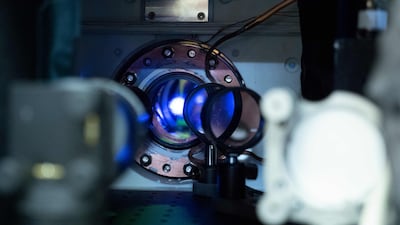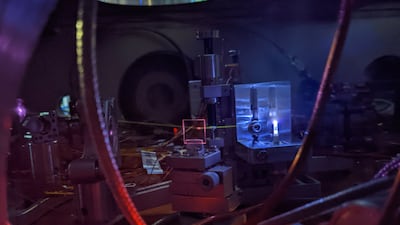Scientists say they have found the 'key ingredients' to create the first nuclear clock which could advance understanding of time and fundamental physics.
A nuclear clock is a theoretical timekeeping device that measures signals from the nucleus of an atom to provide its 'ticks'.
Although its potential excites scientists, until now it has not been replicated owing to the difficulty of measuring the energy jumps within a nucleus using current technology.
Researchers at JILA, a joint institute of the National Institute of Standards and Technology (NIST) and the University of Colorado Boulder, were able to utilise a ultraviolet laser to precisely measure the frequency of an energy jump in thorium nuclei embedded in a solid crystal.
While this laboratory demonstration is not a fully developed nuclear clock, it contains all the core technology for one, the scientists say.
“We used a laser referenced to the most precise atomic clock to excite the nucleus of thorium atoms and measure the absolute frequency of the nuclear transition”, researchers told The National.
They added that the measurement was “a million times more precise than previous experiments”.
The research has already yielded unprecedented results, including the ability to observe details in the thorium nucleus's shape that no one had ever observed before. Researchers liken this to seeing individual blades of grass from an aircraft.

Atomic clocks are used to configure international time and play major roles in technologies such as GPS, internet synchronisation, and financial transactions.
Nuclear clocks are generally thought to be more precise than atomic clocks, which measure time by tuning laser light to frequencies that cause electrons to jump between energy levels.
The development of nuclear clocks could mean even more precise navigation systems, faster internet speeds, more reliable network connections and more secure digital communications.
“Imagine a wristwatch that wouldn't lose a second even if you left it running for billions of years,” said NIST and JILA physicist Jun Ye. “While we're not quite there yet, this research brings us closer to that level of precision.”
Scientists focused on thorium-229, an atom whose nucleus has a smaller energy jump than any other known atom, requiring ultraviolet light, which is lower in energy than X-rays.
“Since a nuclear clock is based on a nuclear transition within an atom's nucleus as opposed to an electron transition occurring in the atom's electron shell, nuclear clocks can be less sensitive to issues such as electric magnetic fields”, the researchers added.
“Another simple reason is that the frequency of the thorium nuclear transition is higher than most atomic clock frequencies – in general, a clock that ticks faster is able to measure time with more precision.”
Nuclear clocks could further improve tests of fundamental theories for how the universe works, potentially leading to new discoveries in physics.
For example, they could help detect dark matter or verify if the constants of nature are truly constant, allowing for verification of theories in particle physics without the need for large-scale particle accelerator facilities.
Despite the exciting breakthrough, researchers believe that it would take some time for a nuclear clock to surpass the world's best atomic clocks, adding that both were complimentary to each other, especially when it comes to studying fundamental physics.

